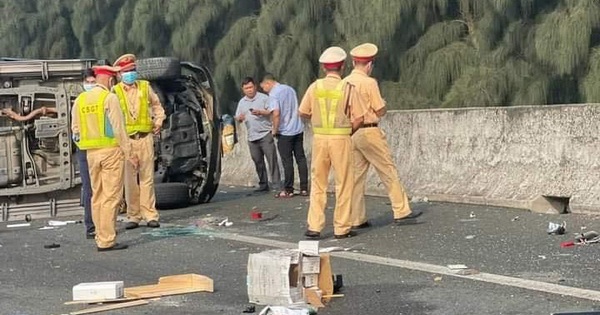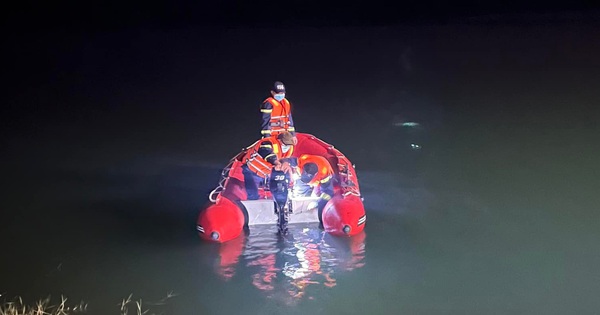An Giang87 km long, 30 m wide, hand digging took 5 years with more than 80,000 workers, Vinh Te was the largest canal in Vietnam during the feudal period 200 years ago.
In the afternoon, old Sau No (70 years old, Phu Nhut, An Phu, Tinh Bien) walked to the edge of Vinh Te canal in front of the house to look at the water level. During the dry season, the water left the beach quite far. Looking at the murky canal flowing sluggishly, Mr. Sau decided to wait until the afternoon for a large amount of water to pump into the plastic tanks for raising eels in the garden. His flock of 5,000 eels has only been thin for a few months, it is expected that after 8-9 months, the first batch will be sold.
“Now the river water is very polluted with faeces, so we have to be careful to make sure,” he said.

Mr. Sau No on the bank of Vinh Te canal, describing the water level in the years of great flood. Image: Hoang Nam
Mr. Sau is a former local resident, from his great-grandfather’s life to his grandchildren’s time, he clung to the land near Vinh Te canal as a livelihood. In the 1990s and earlier, in the dry season of Vinh Te canal, there was a section so shallow that it was bare sand dunes, just rolled up your pants to wade through. In the flood season, the water is immense, “crawling” to the foot of the house on stilts. At that time, the land on both sides of the canal was deserted, people mainly only did one crop a year, yielding just enough food.
In the memory of the old farmer, life was incomplete at that time, but there was no shortage of fish and shrimp all year round. Shrimp, snakehead fish, cotton fish each time catching 4-5 kg is normal, Linh fish go in groups of kilometers long, just put “cow” (a kind of bamboo fishing gear) into the canal to visit once a day. not eat all. There are so many fish that every time it rains, thunders and lightnings, large flocks startle the water and squeal.
The river water at that time was not much polluted, people living along the banks only needed to scoop into the jar, remove the alum to filter it, then they could use it for cooking. In 2000, the residential line in Phu Nhut hamlet was formed. Unfortunately, the wooden stilt house is still new, he asked the “genie” to move the whole house to the line, 60 meters from the old house. At a rare age, 6 hectares of rice land he divided among his 4 children and 7 grandchildren.
Mr. Nguyen Van Thanh, Vice Chairman of An Phu Commune People’s Committee, said that Vinh Te canal passes through Phu Nhut hamlet, Phu Tan, with a length of over 4.5 km. The whole commune has over 400 hectares of double-crop rice and fruit trees. Every year in the dry season, because it is difficult for boats to travel because the canal bed is dry, rice drivers have to hire small ships to transship rice, so farmers’ purchasing rates are lower.
“Trains and boats that run aground have to wait 6-7 hours for high water to go, there are cases where a boat carrying rice runs aground, overturns, and all the rice is dumped into the river.”

Vinh Te canal section through An Phu commune, on the left side of the canal is a branch that guides the stream when the main canal is drained to destroy reefs. Image: Hoang Nam
About a kilometer from Mr. Sau’s house, in the last days of April, the Vinh Te canal dredging project is in its final stage, with only about 4 km remaining. The project has a total capital of 200 billion VND for 46 km of the canal section to be dredged. After renovation, the canal bottom will be 35 m wide, 3.5 m deep, and 7 m deep.
However, Mr. Nguyen Van Du, Director of An Giang Agricultural and Traffic Construction Investment Project Management Board, said that the most difficult part of the project is only two kilometers away. Because the canal through An Phu commune (Tinh Bien) below there are many reefs. The construction unit has to dig another 20m wide canal, parallel to this canal for temporary ships, then build two ends of the canal to block the flow and drain the water.
Several options for breaking the rock were proposed, the last of which used explosives. However, the bottom of the canal is mainly young rock and sandstone, so it is less expensive to split the rock and take it away. Initially, the construction unit used an excavator to scrape the rock but could not, then had to change to the option of attaching the hammer head to the excavator to break the rock.
“Only the two-kilometer section, but it took nearly a year to complete, then we can see the efforts of the ancestors nearly 200 years ago,” Mr. Du said.
Upstream of history, according to author Nguyen Van Hau in the book Thoai Ngoc Hau and the discoveries of Hau Giang regionthe governor of Vinh Thanh town Nguyen Van Thoai (Thao Ngoc Hau) was the one who directly commanded the excavation of Vinh Te canal.
To make the canal straight, the ancients waited at night, turned wild reeds, lit torches on top of the poles, and then aimed in a straight line. Wanting to control those “fire poles” in a straight line, the group of workers holding a large illuminator, standing on high, waved back and forth to signal the person holding the pole to find the right position.

Vinh Te canal flows through An Giang and Tien Giang provinces. Graphics: Khanh Hoang
The canal digging took up to 5 years, from December 1819 to May 1824 divided into three phases. In total, more than 80,000 people must be mobilized. The canal is 87 km long, the average width is 30 m, and the average depth is about 2.55 m. Except for the existing canals, the new section of canals that need to be excavated is 37 km.
To speed things up, authorities sometimes force militiamen to work all night. There are sections near the foot of the mountain, the soil is full of rocks and gravel, so you have to use a thick-edged iron spade to dig down with a mallet. There are many cases due to sleepiness because they have to work at night. The workers lost their hands and beat each other on the head and died.
In addition, there are tigers stalking people, many poisonous snakes, diseases, many people have fled. Those caught again will be punished with continuous hard labor on the construction site. Those who are lucky enough to escape and get lost in the forest will surely die of hunger and become prey for wild animals.
At that time, there were many sharks on the Vam Nao river. The defectors waited late at night, gathered in large groups, each holding a banana tree to make a floating tube, then jumped into the water one at a time and waded so that the fish could not eat in time. Yet, out of ten people, only three out of ten survive, and sometimes their limbs are amputated.
In the 16th year of Minh Mang (1835), the king ordered Cuu Dinh to be cast as a national treasure and symbolize the eternity of the royal family, Vinh Te canal was carved on the top. Mrs. Chau Thi Te, wife of Thoai Ngoc Hau of Chau Vinh family, for her merit in helping her husband dig the canal, was also named the canal by the king.

The first part of Vinh Te canal is adjacent to Chau Doc river. Image: Hoang Nam
Born in Ba Chuc town, Tri Ton district, Prof. Dr. Vo Tong Xuan said that Vinh Te canal not only brings fresh water and alluvium to cultivate An Giang fields, but also the Long Xuyen quadrangle and the whole region. area adjacent to Cambodia. Since then, many localities have gradually expanded the area of rice cultivation. Previously, when there was no road, traders who wanted to go to remote areas to buy agricultural products had to go through this channel.
In addition to playing a strategic role in defense, Vinh Te canal is also a lifeline of goods trading from Chau Doc city to Ha Tien city, goods from abroad from there are also convenient to enter Vietnam.
“The prerequisite to help a country develop is convenient transportation, which shows the strategic vision of our ancestors hundreds of years before the Vinh Te canal was dug,” said Prof. Dr. Vo Tong Xuan.
After 198 years, alluvium on Vinh Te canal continues to follow in the footsteps of people, cultivating life in the remote An Phu region in the literal sense. A residential project is being formed, the lower foundation is accreted from 120,000 tons of mud recovered in the process of dredging the canal.
“After this route is completed, we will continue to invest in infrastructure to support the remaining 300 households living along the canal,” said Vice Chairman of An Phu Commune People’s Committee.
The rhythm of life by the Vinh Te canal. Video: Hoang Nam
Hoang Nam
at Blogtuan.info – Source: vnexpress.net – Read the original article here




